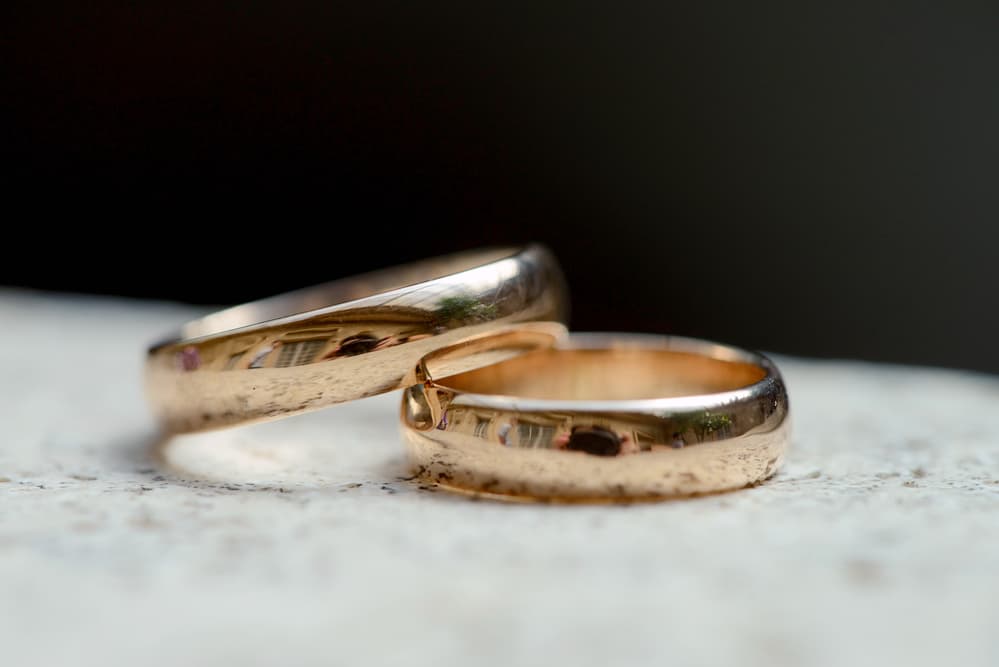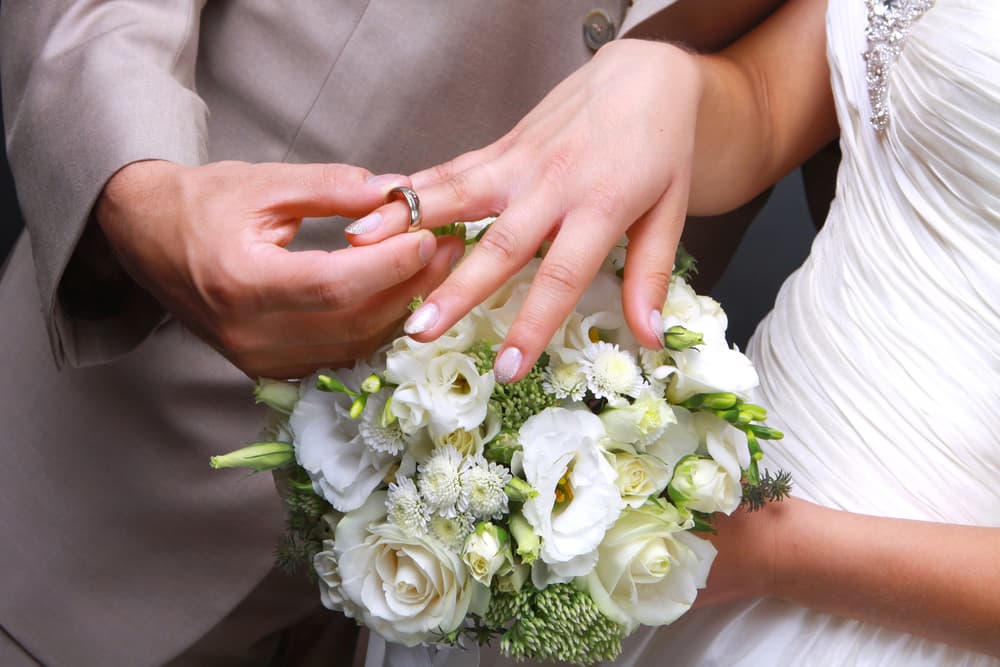The history of wedding rings is a fascinating journey that shows how this small piece of jewelry has become a significant symbol of love and commitment.
From ancient times to modern days, wedding rings have evolved in their design and meaning.
This article explores where wedding rings came from, how they have changed over time, and the latest trends and innovations in wedding rings today.
Now, what is the origin of wedding rings?

The origin of wedding rings started with the tradition of exchanging wedding rings dating back thousands of years, tracing its roots to ancient civilizations that imbued these small bands with deep symbolic meaning.
The origins and history of the wedding ring can be found in several ancient cultures, each contributing to the development of this enduring tradition.
The ancient Egyptians are often credited with originating the practice of exchanging rings during wedding ceremonies. They viewed the circle as a powerful symbol of eternity, with no beginning or end, mirroring the eternal nature of the sun and moon.
Couples exchanged rings made of braided reeds, hemp, or leather, and later, more durable materials like ivory and bone. These rings were worn on the fourth finger of the left hand, a tradition still prevalent today, based on the belief that this finger contained a vein directly connected to the heart, known as the "Vena Amoris" or "Vein of Love."
In ancient Rome, the exchange of rings became a formal part of the betrothal process. Iron rings were commonly used, symbolizing strength and permanence.
As time progressed, gold rings became more popular, denoting wealth and social status. Roman rings often featured intricate designs, including clasped hands, known as "fede" rings, which symbolized trust and fidelity. The Romans also popularized the custom of engraving messages or the couple's initials inside the ring, a practice that continues to this day.
The Greeks also played a significant role in the history of wedding rings. Greek rings often depicted Eros or Cupid, the god of love, reinforcing the romantic aspect of the marriage bond.
The Greeks adopted and adapted the Egyptian and Roman traditions, creating their unique styles and symbolisms. Greek philosophers and writers frequently mentioned the significance of the wedding ring in their works, further embedding the tradition in Western culture.
Other ancient cultures, such as the Hebrews and early Christians, also embraced the use of wedding rings, though with variations in materials and meanings.
The Hebrews initially used rings made of simple metal bands, which later evolved into more elaborate designs incorporating precious stones.
Early Christians initially viewed rings with skepticism due to their pagan origins but eventually adopted them as symbols of eternal love and divine union.
Wedding rings have transcended their ancient origins to become universal symbols of love, commitment, and cultural identity.
Their symbolism and significance have evolved, reflecting changes in societal values, religious beliefs, and artistic trends.
During the Middle Ages, the Christian Church began to formalize marriage rituals, incorporating the exchange of rings as a central element. Rings were often blessed during the ceremony, emphasizing their sacred nature.
The use of precious metals and gemstones became more prevalent, with diamonds, believed to possess unmatched durability and beauty, becoming especially favored. The tradition of wearing the ring on the left hand's fourth finger persisted, reinforcing the symbolic connection to the heart.
In the Renaissance and Baroque periods, wedding rings became even more elaborate and ornate. Rings were often designed with intricate engravings, enamel work, and the inclusion of multiple gemstones.
Posy rings, engraved with poetic inscriptions or romantic messages, became popular as tokens of love and fidelity. The increasing availability of gold and silver allowed for more elaborate designs, reflecting the wearer's social status and personal wealth.
The Victorian era saw a revival of intricate and symbolic designs, influenced by Queen Victoria's own love for elaborate jewelry. Rings often featured hearts, flowers, and other romantic motifs, sometimes incorporating the couple's birthstones.
The Edwardian era continued this trend, with an emphasis on delicate and intricate designs using platinum and diamonds. This period also saw the rise of the "eternity ring," a band set with a continuous line of identical gemstones, symbolizing unending love.
In the 20th century, wedding rings became more standardized and widely accessible. The discovery of diamond mines in South Africa and successful marketing campaigns, such as De Beers' famous "A Diamond is Forever" slogan, popularized diamond engagement rings as a cultural norm.
Contemporary wedding rings range from traditional gold bands to custom-designed pieces featuring unique materials and modern designs. Today, wedding rings are not only symbols of marital commitment but also expressions of personal style and identity.
Different cultures around the world have imbued wedding rings with their unique traditions and meanings. In many Asian cultures, wedding rings are often exchanged during elaborate ceremonies, symbolizing not just the union of two individuals but also the joining of families.
In Indian culture, the exchange of rings is part of the larger wedding ritual, with rings often featuring intricate designs and precious stones.
In some African cultures, rings made from local materials such as wood or beads hold significant cultural value, reflecting the community's heritage and craftsmanship.
The evolution of diamond wedding rings intertwines historical events, marketing genius, and changing social norms.
Over centuries, diamonds have transitioned from rare and mystical stones to the quintessential symbol of eternal love and commitment.
Diamonds have been admired and adorned since ancient times. However, it wasn't until the Middle Ages that they began to appear in jewelry.
The earliest known diamond engagement ring was given by Archduke Maximilian of Austria to Mary of Burgundy in 1477, marking a significant shift in the perception of diamonds as symbols of love and commitment. This gesture set a trend among European aristocracy, though diamonds remained a rarity reserved for the wealthy.
During the Renaissance, advancements in diamond cutting techniques enhanced the stone's allure. The introduction of the "table cut" allowed for more brilliance and sparkle. By the Victorian era, diamond rings were becoming more common among the affluent middle class.
Queen Victoria's own love for jewelry, including diamond pieces, significantly influenced societal trends. Victorian engagement rings often featured diamonds in combination with other gemstones, reflecting the romantic and ornate styles of the period.
The discovery of vast diamond mines in South Africa in the late 19th century dramatically increased the availability of diamonds.
The De Beers Consolidated Mines, established in 1888, played a pivotal role in controlling the diamond supply and marketing the gems. The company’s strategies ensured that diamonds remained perceived as rare and valuable despite their increased availability.
The most transformative moment in the history of diamond wedding rings came in 1947 with De Beers' iconic advertising slogan, "A Diamond is Forever." This campaign, crafted by the N.W. Ayer advertising agency solidified the idea that diamond rings are the ultimate symbol of eternal love and commitment.
The slogan’s enduring appeal persuaded generations of consumers that diamonds were the only suitable choice for engagement and wedding rings. This marketing triumph turned diamond rings into an essential part of Western wedding traditions.
Post-World War II economic prosperity further boosted the popularity of diamond wedding rings. The 1950s and 1960s saw an explosion in demand, with Hollywood and popular culture reinforcing the association between diamonds and romance.
Engagement rings featuring solitaire diamonds became the norm, epitomized by the classic Tiffany setting introduced by Tiffany & Co. in 1886, which showcased the diamond to maximize its brilliance.

As societal values and technological advancements continue to evolve, so too do the trends and innovations in wedding ring design.
The modern era has seen a diversification in styles, materials, and personal expressions in wedding rings.
One of the most significant trends in recent years is the move towards customized and personalized wedding rings. Couples now seek rings that reflect their unique relationship and individual tastes.
This trend has led to an increase in bespoke jewelry services where rings are designed to the customers' specifications, often incorporating personal elements such as birthstones, engravings, or unique designs.
The awareness of ethical and environmental issues has influenced the wedding ring market significantly. Consumers are increasingly prioritizing conflict-free diamonds and sustainable practices.
Lab-grown diamonds, which are chemically and physically identical to natural diamonds but created in controlled environments, have gained popularity as an ethical and often more affordable alternative.
Also, recycled metals and fair-trade practices are becoming standard considerations for conscientious buyers.
Modern couples are also exploring alternatives to traditional diamond rings. Colored gemstones such as sapphires, emeralds, and rubies are being chosen for their vibrant hues and unique significance.
Materials such as titanium, tungsten, and even wood or silicone are being used to create rings that are durable and often more practical for everyday wear. These alternatives allow for greater expression of personal style and can often be more budget-friendly.
Advances in technology have revolutionized ring design and manufacturing. 3D printing and computer-aided design (CAD) allows for precise and intricate designs that were previously difficult to achieve. These technologies enable jewelers to experiment with new forms and patterns, resulting in innovative and contemporary styles.
Smart rings incorporating technology for health tracking or communication have also started to emerge, blending traditional symbolism with modern functionality.
Stackable rings and multi-band designs are another popular trend. These rings can be worn together or separately, offering versatility and a contemporary aesthetic.
Stackable rings often allow for the inclusion of various metals, gemstones, and textures, providing a layered look that can be personalized and adapted over time.
Nostalgia for the past has led to a resurgence in vintage and antique wedding ring styles. Rings inspired by the Art Deco, Victorian, and Edwardian eras are sought after for their intricate details and timeless elegance.
Many couples are choosing authentic antique rings or new rings designed in vintage styles, appreciating the history and craftsmanship these pieces represent.
Contrasting with the ornate vintage styles, there is also a strong trend towards minimalist and modern designs. Sleek, simple bands with clean lines and understated elegance appeal to those who prefer a more contemporary and subtle aesthetic.
These designs often focus on high-quality materials and impeccable craftsmanship, emphasizing purity and refinement.
The history of wedding rings reveals how much they have changed and developed over the centuries.
From their ancient origins to their modern designs, wedding rings have always been important symbols of love.
As trends continue to evolve, wedding rings remain a special part of marriage traditions around the world.
Ancient wedding rings were made from braided reeds, hemp, leather, ivory, bone, iron, and bronze. The Romans introduced gold and often decorated their rings with intricate designs, symbolizing strength and eternity.
Humans started wearing wedding rings in ancient Egypt around 3000 BCE. Egyptians believed the circular shape symbolized eternity and wore rings on the fourth finger of the left hand, thought to connect to the heart. Greeks and Romans later adopted and adapted this tradition.
Native Americans typically did not use wedding rings. Instead, they used different symbols and rituals, such as the exchange of gifts or beaded jewelry, to signify marriage. Some tribes used rings made from natural materials like wood, shells, or stones.
What does a wedding ring symbolize? Find out here and explore different types of wedding rings, how to wear them, and care tips to keep your ring beautiful and lasting.
Read MoreDo silicone rings stretch? Understand their flexibility with our guide, explore how much they can expand, why stretching might be beneficial for you and more.
Read MoreDoes tungsten turn your finger green? Discover the truth here, learn about the cause of green finger discoloration, and how you can prevent the issue.
Read MoreDiscover what are hypoallergenic earrings, their benefits, and the common materials used. Learn how to choose earrings that won't cause irritation or allergies.
Read More